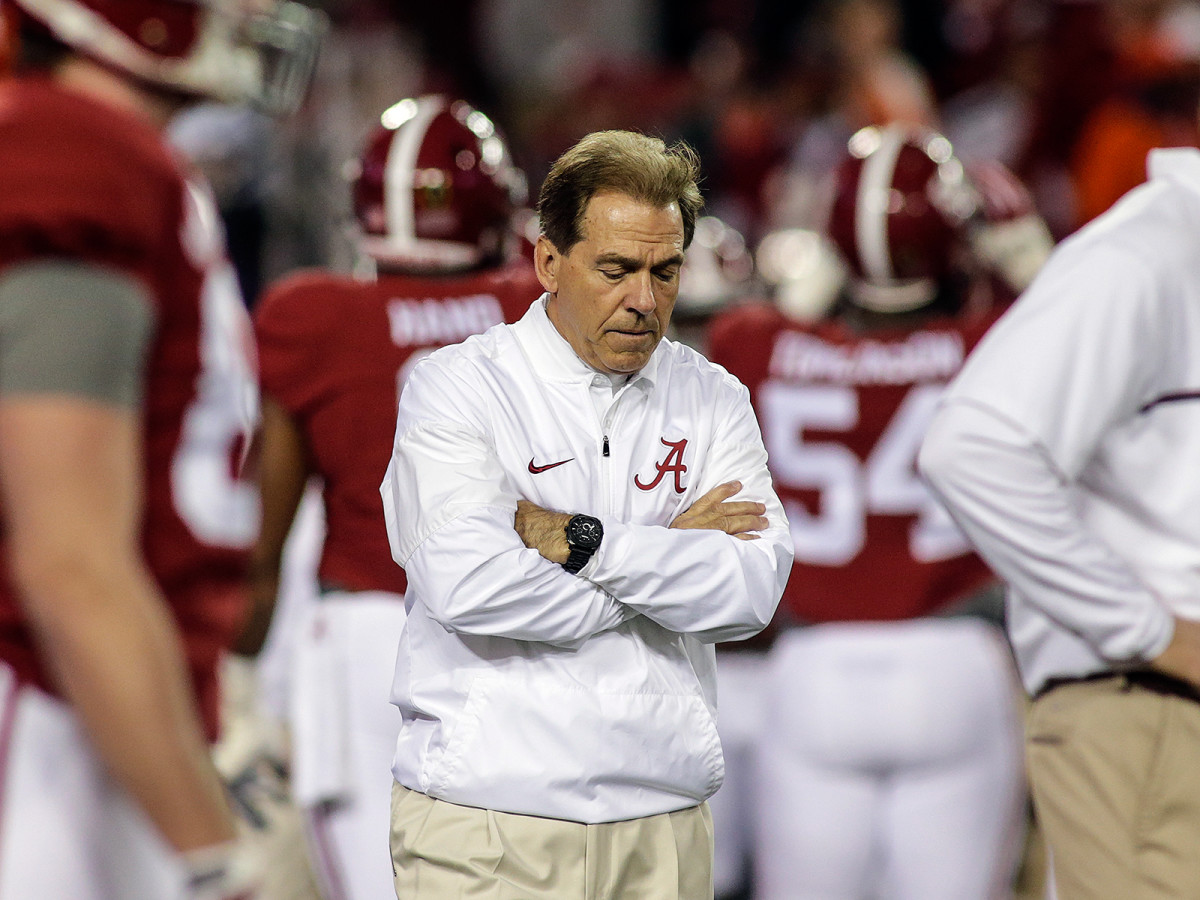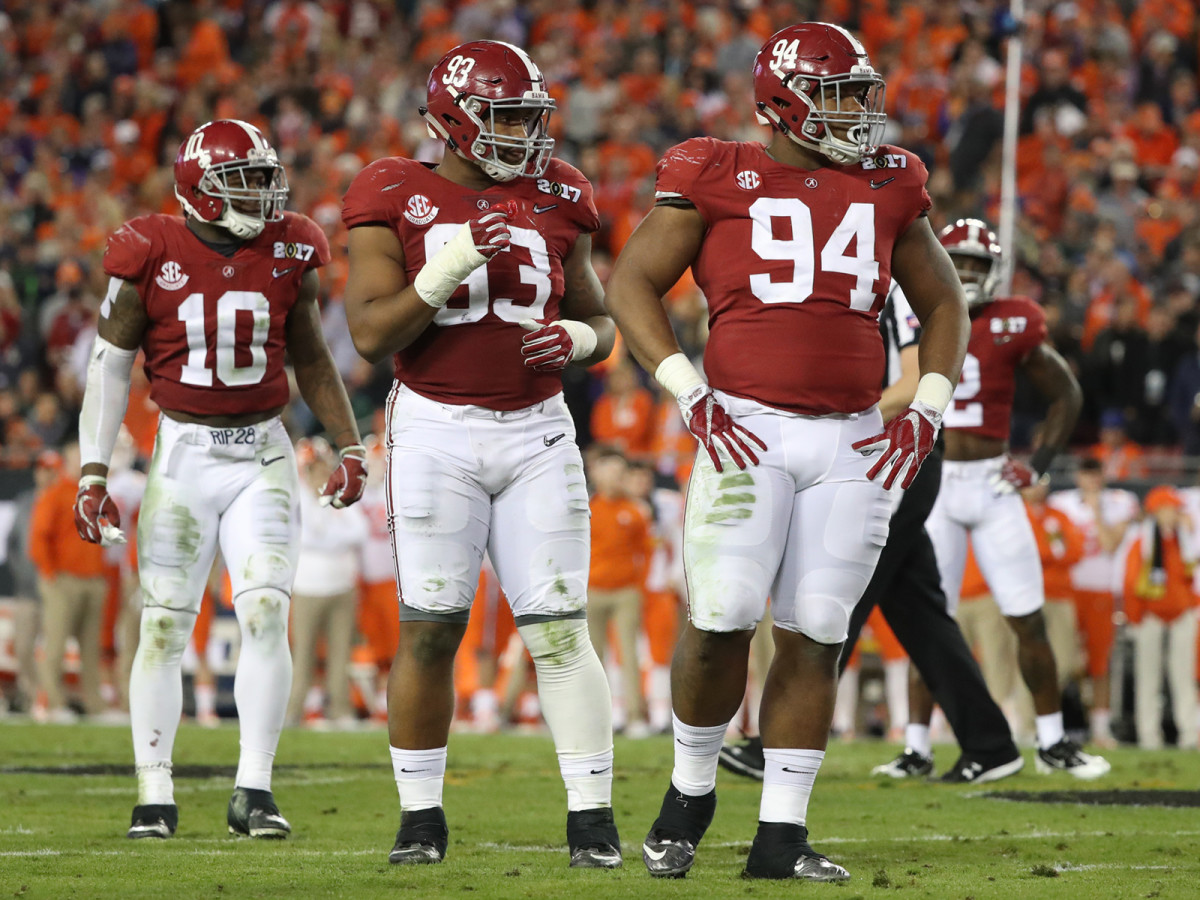How Do You Beat Bama? College Football's Ultimate Question Has No Good Answer

When Nick Saban took over as Alabama’s coach before the 2007 season, the Crimson Tide were coming off a 6–7 campaign and hadn’t had back-to-back seasons with double-digit wins since 1991–92. Their last national title had been 25 years earlier, their last SEC title in 1999.
The first day of September marks the beginning of the second decade of Saban’s coaching career in Tuscaloosa. In 2007 his first team beat Western Carolina 56–2 (the victory would later be vacated as part of sanctions laid on the previous regime) en route to a 6–2 start, then went 1–4 to end the season, and despite two wins over ranked opponents that year, the program still looked to be a step behind the SEC’s best.
By 2008, though, Saban had made his mark, and four national championships later, Alabama has set the standard in college football. According to FiveThirtyEight’s Elo ratings, five of Saban’s Tide teams (2016, ’15, ’13, ’12 and ’11) crack the top 20 all-time, and after not having a single player drafted into the NFL after the 2007 season, Alabama has seen 65 of its players picked in the next nine years, including 22 in the first round. Saban didn’t just turn a wayward college football institution into a contender again; he elevated a great program to an unstoppable force.
Week 1 Picks: Will Top 25 Teams Survive Their Season-Opening Tests?
Alabama’s .862 winning percentage since the start of 2007 is college football’s best—Ohio State comes in second at .841. And of the 10 winningest teams in that timeframe, only two other than Alabama spent the entire decade with the same coach throughout: Oklahoma and TCU. (After Bob Stoops’s retirement, it’s down to just Gary Patterson in Fort Worth.) That is to say: Even at the top of the game, the pressure to win consistently claims many victims, and Saban has barely once faltered.
Alabama lost last year’s national title game in heartbreaking fashion, and eight months later it seems like all of college football has collectively forgotten that failure. That counts as a misstep, sure, but it’s hard to look at what Alabama did a season ago and call that loss anything other than an outlier, an untimely bad break suffered against an exceptional team. Clemson has provided the best model to date of how to beat the Crimson Tide, and it’s damn near impossible: Hire a coach with ties to Saban’s Alabama, give him close to a decade to build his program and recruit the best players in the game. Learn from one championship game loss at the hands of Saban, bank on some better luck, and groom a top recruit into the best quarterback in the country, and maybe on his second try, he’ll edge Alabama by five points. That’s not to diminish what the Tigers accomplished; it’s just the reality of college football in 2017.

There is no rule of thumb, no universal explanation for each of Alabama’s eight losses since 2011, the season when Saban won his second national title in Tuscaloosa and established that the dominant run Alabama was on might look something more like a dynasty. When the Tide lost the national title game last winter, there was simply an equally talented team in their path. Against Ole Miss in ’15, the defense faltered worse than it had in years, and against the same Rebels in ’14, it may have rested too easy on a 14–3 halftime lead. In the Sugar Bowl to end the ’14 season, Cardale Jones and Ohio State edged Alabama by a touchdown in a high-scoring game en route to the Buckeyes’ national title. There was the Kick-Six in ’13 against Auburn and a high-flying Oklahoma offense a few weeks later in the Sugar Bowl. In ’12, there was Johnny Manziel. In ’11, Alabama came up on the short end of one of the greatest defensive battles in history in a 9–6 loss to LSU.
And that’s the list. There’s no through line, no hidden key. When I reached out to coaches who have faced the Tide in recent seasons, few wanted to discuss what it might take to topple Alabama. Brian Rock, who was Kent State’s offensive coordinator in 2011 when it lost to Alabama, 48–7, could only laugh and accuse me of bringing up bad memories. Nothing surprised him that day—not a move the Tide made—as three Alabama running backs combined for five touchdowns and Kent State was unable to capitalize upon five Crimson Tide turnovers, finishing with just 90 yards of total offense. “I can remember those linebackers they had, they were just unbelievably fast and physical,” Rock recalls. “You’d think, oh, we’re going to get around the edge, and then, wham. Their closing speed was [amazing]. As soon as the hole opened, boom, it was closed.”
And though that speed, largely on defense and in the running game, has marked Saban’s teams since, Rock says it may not be the key to beating them. He’s careful to point out that emulating a great team is hardly the best way to ensure an upset. “This formula works for him, and for Alabama, and people want to be associated with that,” he says. “It doesn’t mean that it’s the only way. If you try to be somebody you’re not, you’ll fail.”
In fact, consider the Tide’s three losses in postseason games since 2011: two Sugar Bowls and last year’s national title game. All three opponents—Oklahoma in ’14, Ohio State in ’15 and Clemson in ’16—boasted some of the country’s best offensive units and playmakers in those seasons, while those Alabama teams staked their reputation primarily on defense. If there’s anything to learn from those games, it’s that the teams with the best shot against Alabama featurea historically good offenses, play to their strengths and find a way not to be completely frustrated by Saban’s airtight defense.

Months after losing 10 players to the 2017 NFL draft—seven of whom went in the first or second rounds—Alabama is back on top of the polls going into the season opener against Florida State on Saturday. Roster attrition and even recent on-field setbacks don’t faze voters when it comes to the Crimson Tide. Instead, Alabama receives 13 times as many first-place votes as the team with the next most, and ho hum, another season begins.
The SEC was stacked even before Saban starting leading Alabama back to the top of it. The 2007 preseason AP poll featured two teams from the conference (No. 2 LSU and No. 6 Florida) in the top 10 and four more (No. 13 Georgia, No. 15 Tennessee, No. 18 Auburn and No. 21 Arkansas) in the top 25. South Carolina, Kentucky and Alabama would all crack the poll at some point in the season, and LSU and Georgia held the No. 1 and No. 2 spots, respectively, in the final BCS rankings. Between ’06 and ’10, the SEC won five straight national titles—Florida took home two championships, LSU one, Auburn one and Alabama one. Throughout this decade, it has remained a premier conference, but the emergence of Alabama has somewhat stratified the league; Alabama was the only one of the SEC’s six teams to crack the top 10 of this summer’s preseason AP poll. And since Auburn’s 2010 championship, the Tide have all three of the SEC’s national titles.
There are signs that other conferences have closed the gap; last season the SEC went 11–14 in nonconference games against Power 5 teams, its first losing mark of the past decade. Over the past three seasons, that record has been 36–31, compared with 37–16 in the three years before that. Alabama went 6–2 against non-SEC Power 5 opponents from 2014–16. Overall, the Crimson Tide’s average margin of victory has been greater than 20 points in each of Saban’s 10 seasons except for 2007, and it has been greater than 30 points three times. In conference games, SEC teams scored an average of just 14.9 points against Alabama in 2016, and SEC opponents have averaged more than 15 points per game against the Tide just five times in Saban’s 10 seasons.
2018 NFL Mock Draft: Which College Stars Should Pro Fans Follow This Fall?
Even at their best, though, they’ve still faced stiff competition. Despite fielding some of the past decade’s best teams, none of the 10 highest point differentials over the past 10 years belong to Alabama teams (2008 Florida is the only SEC team on the list). That’s in large part because of the number of good teams the Crimson Tide plays each year: Since 2007, Alabama has faced 66 ranked opponents, the most of any FBS team; for comparison, Ohio State has played against just 41. With a 50–16 record in such games, Alabama leads all teams in winning percentage against ranked opponents during Saban’s tenure. Only three of Alabama’s losses have come to unranked teams.
Has Alabama elevated the SEC? That depends how you look at the question. Having a team that’s consistently ranked No. 1 has certainly kept the conference at the forefront of college football, but Alabama’s presence hasn’t consistently raised the SEC’s overall level of play, and you could even make the case it’s fallen off a bit in recent years. On defense, where the Crimson Tide dominates year after year, the SEC is consistently among the best in college football, but the Big Ten’s units have bested the SEC’s overall numbers often, as did the Pac-12 a season ago. The mere presence of Alabama hasn’t been enough to drag the entire conference into an era of elite defense, which may be a good thing. An army of would-be Alabama clones would hardly be fun to watch—nor any more likely to topple the original.
